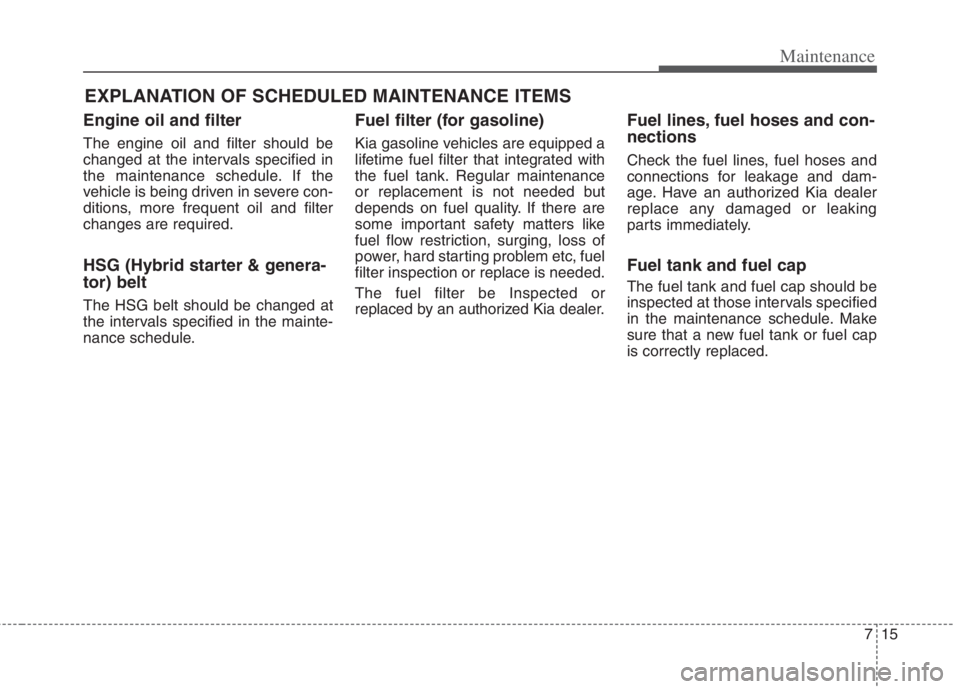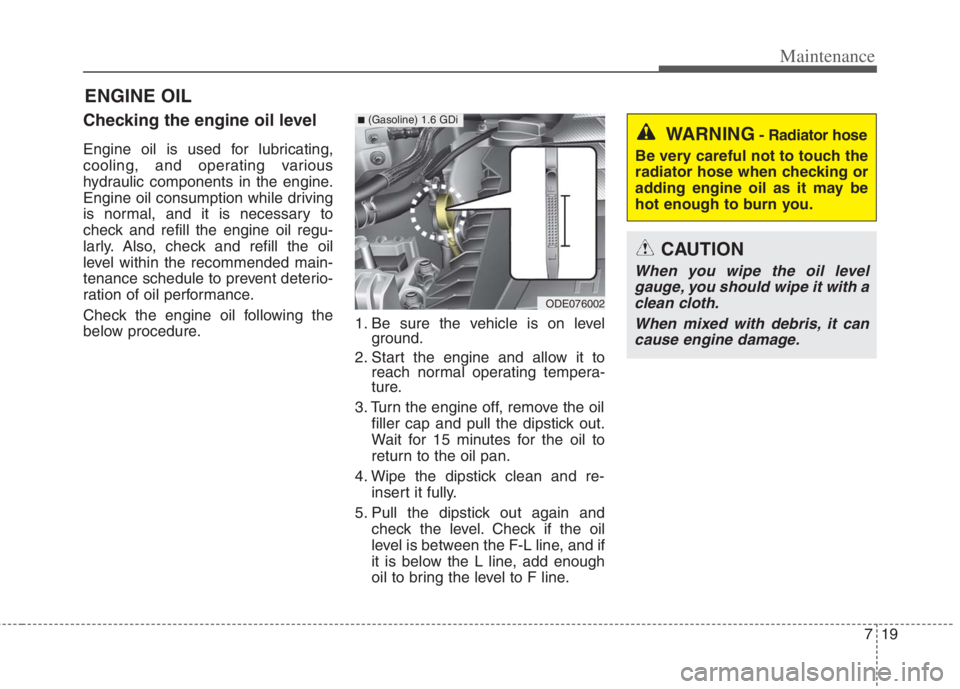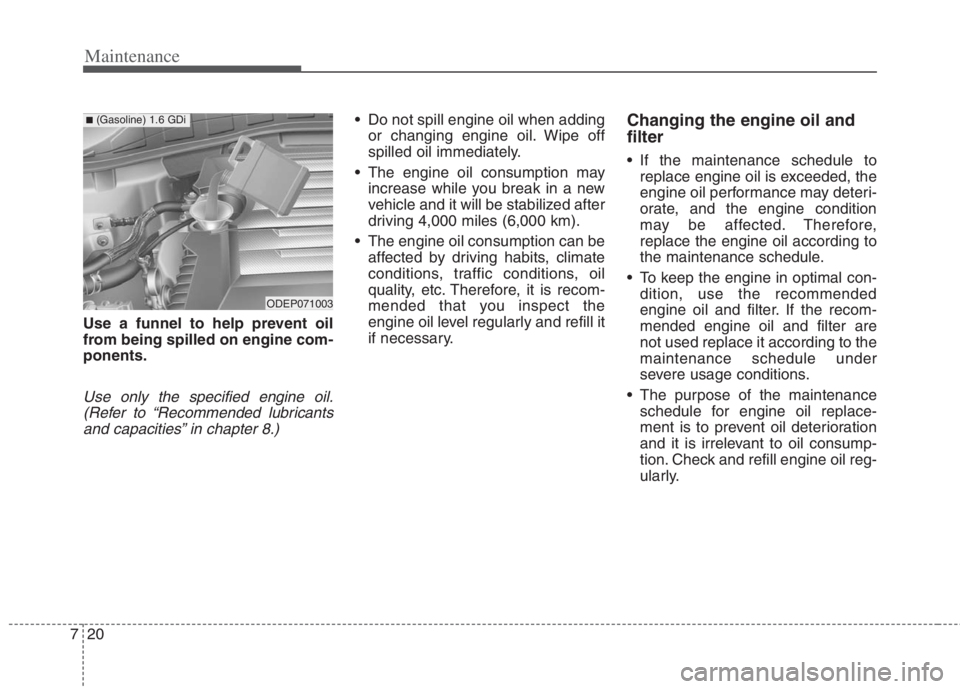Page 552 of 684

Maintenance
10 7
Normal Maintenance Schedule - Non Turbo Models
The following maintenance services must be performed to ensure good emission control and performance.
Keep receipts for all vehicle services to protect your warranty. Where both mileage and date are shown, the frequen-
cy of service is determined by whichever occurs first.
Number of months or driving distance, whichever comes first
Months1224364860728496108120132144156168180
Miles×1,0007.51522.530 37.5 45 52.5 60 67.5 75 82.5 90 97.5 105 112.5
Km×1,00012 24 36 48 60 72 84 96 108 120 132 144 156 168 180
Rotate tiresRotate every 12,000 km (7,500 miles)
Fuel additives *1Add every 12,000 km (7,500 miles) or 12 months
Engine oil and engine oil
filter *2(Gasoline) 1.6 GDiRRRRRRRRRRRRRRR
Climate control air filter-R-R-R-R-R-R-R-
Engine clutch actuator fluidIRIRIRIRIRIRIRI
Air cleaner filterIIIRIIIRIIIRIII
Coolant (Engine)At first, replace at 192,000 km (120,000 miles) or 10 years, after that,
replace every 48,000 km (30,000 miles) or 24 months
Brake fluidInspect every 12,000 km (7,500 miles) or 12 months,
Replace every 48,000 km (30,000 miles) or 48 months
HSG belt *3Inspect every 12,000 km (7,500 miles) or 12months,
Replace every 96,000 km (60,000 miles) or 48 months
Spark plugs(Gasoline) 1.6 GDiReplace every 150,000 km (100,000 miles) or 120 months
MAINTENANCE
INTERVALS
MAINTENANCE
ITEM
Page 553 of 684
711
Maintenance
Number of months or driving distance, whichever comes first
Months1224364860728496108120132144156168180
Miles×1,0007.51522.530 37.5 45 52.5 60 67.5 75 82.5 90 97.5 105 112.5
Km×1,00012 24 36 48 60 72 84 96 108 120 132 144 156 168 180
Battery condition
IIIIIIIIIIIIIII
Vacuum hose
Air conditioner compressor/refrigerant
Exhaust system
Brake lines, hoses and connections
(Including booster)
Brake discs and pads
Suspension ball joints
Steering gear rack, linkage and boots
Driveshaft and boots
Engine clutch actuator hose and lines
Cooling system hoses and connections
Inspect every 12,000 km (7,500 miles) or 6 monthsClutch (if equipped) and brake pedal
free play
Parking brake
-I-I-I-I-I-I-I-Fuel tank and fuel cap, fuel tank and
canister
Fuel tank air filter *4
MAINTENANCE
INTERVALS
MAINTENANCE
ITEM
Normal Maintenance Schedule - Non Turbo Models(CONT.)
Page 554 of 684

Maintenance
12 7
Number of months or driving distance, whichever comes first
Months1224364860728496108120132144156168180
Miles×1,0007.51522.530 37.5 45 52.5 60 67.5 75 82.5 90 97.5 105 112.5
Km×1,00012 24 36 48 60 72 84 96 108 120 132 144 156 168 180
All latch, hinges and locksInspect every 24,000 km (15,000 miles) or 12 months
Cooling system---I-I-I-I-I-I-
Fuel lines, hoses and connections---I---I---I---
Dual clutch transmission fluid----I----I----I
MAINTENANCE
INTERVALS
MAINTENANCE
ITEM
Normal Maintenance Schedule - Non Turbo Models (CONT.)
I : Inspect and if necessary, adjust, correct, clean or replace.
R : Replace or change.
*1: If TOP TIER Detergent Gasoline is not available, one bottle of additive is recommended. Additives are available from your author-
ized Kia dealer along with information on how to use them. Do not mix other additives.
*2: As it is normal for engine oil to be consumed during driving, the engine oil level should be checked on regular basis. The engine
oil change interval for normal operating conditions is based on the use of the recommended engine specification. If the recom-
mended engine oil specification is not used, then replace the engine oil according to the maintenance schedule under severe
operating conditions.
*3: Inspect HSG belt for evidence of cuts, cracks, excessive wear or oil saturation and replace if necessary. If HSG belt noise
occurred, readjust HSG belt tension before replace.
*4: Fuel tank air filter are considered to be maintenance free but periodic inspection is recommended for this maintenance sched-
ule depends on fuel quality.
Page 557 of 684

715
Maintenance
EXPLANATION OF SCHEDULED MAINTENANCE ITEMS
Engine oil and filter
The engine oil and filter should be
changed at the intervals specified in
the maintenance schedule. If the
vehicle is being driven in severe con-
ditions, more frequent oil and filter
changes are required.
HSG (Hybrid starter & genera-
tor) belt
The HSG belt should be changed at
the intervals specified in the mainte-
nance schedule.
Fuel filter (for gasoline)
Kia gasoline vehicles are equipped a
lifetime fuel filter that integrated with
the fuel tank. Regular maintenance
or replacement is not needed but
depends on fuel quality. If there are
some important safety matters like
fuel flow restriction, surging, loss of
power, hard starting problem etc, fuel
filter inspection or replace is needed.
The fuel filter be Inspected or
replaced by an authorized Kia dealer.
Fuel lines, fuel hoses and con-
nections
Check the fuel lines, fuel hoses and
connections for leakage and dam-
age. Have an authorized Kia dealer
replace any damaged or leaking
parts immediately.
Fuel tank and fuel cap
The fuel tank and fuel cap should be
inspected at those intervals specified
in the maintenance schedule. Make
sure that a new fuel tank or fuel cap
is correctly replaced.
Page 558 of 684

Maintenance
16 7
Vacuum crankcase ventilation
hoses
Inspect the surface of hoses for evi-
dence of heat and/or mechanical
damage. Hard and brittle rubber,
cracking, tears, cuts, abrasions, and
excessive swelling indicate deterio-
ration. Particular attention should be
paid to examine those hose surfaces
nearest to high heat sources, such
as the exhaust manifold.
Inspect the hose routing to assure
that the hoses do not come in con-
tact with any heat source, sharp
edges or moving component which
might cause heat damage or
mechanical wear. Inspect all hose
connections, such as clamps and
couplings, to make sure they are
secure, and that no leaks are pres-
ent. Hoses should be replaced
immediately if there is any evidence
of deterioration or damage.
Air cleaner filter
A Genuine Kia air cleaner filter is
recommended when the filter is
replaced.
Spark plugs
Make sure to install new spark plugs
of the correct heat range.
When assembling parts, be sure to
wipe the inside and outside of the
boot bottom of the ignition coil and
the insulator of the spark plug with a
soft cloth to prevent contamination of
the spark plug insulator.
Cooling system
Check the cooling system compo-
nents, such as the radiator, coolant
reservoir, hoses and connections for
leakage and damage. Replace any
damaged parts.
Coolant (Engine / Inverter)
The coolant should be changed at
the intervals specified in the mainte-
nance schedule.
Page 559 of 684
717
Maintenance
Dual clutch transmission Fluid
Inspect the dual clutch transmission
fluid according to the maintenance
schedule.
Brake hoses and lines
Visually check for proper installation,
chafing, cracks, deterioration and
any leakage. Replace any deteriorat-
ed or damaged parts immediately.
Brake fluid
Check the brake fluid level in the
brake fluid reservoir. The level should
be between “MIN” and “MAX” marks
on the side of the reservoir. Use only
hydraulic brake fluid conforming to
DOT 4 specification.
Parking brake
Inspect the parking brake system
including the parking brake pedal
and cables.
Brake discs, pads and calipers
Check the pads for excessive wear,
discs for run out and wear, and
calipers for fluid leakage.
Page 561 of 684

719
Maintenance
ENGINE OIL
Checking the engine oil level
Engine oil is used for lubricating,
cooling, and operating various
hydraulic components in the engine.
Engine oil consumption while driving
is normal, and it is necessary to
check and refill the engine oil regu-
larly. Also, check and refill the oil
level within the recommended main-
tenance schedule to prevent deterio-
ration of oil performance.
Check the engine oil following the
below procedure.1. Be sure the vehicle is on level
ground.
2. Start the engine and allow it to
reach normal operating tempera-
ture.
3. Turn the engine off, remove the oil
filler cap and pull the dipstick out.
Wait for 15 minutes for the oil to
return to the oil pan.
4. Wipe the dipstick clean and re-
insert it fully.
5. Pull the dipstick out again and
check the level. Check if the oil
level is between the F-L line, and if
it is below the L line, add enough
oil to bring the level to F line.
CAUTION
When you wipe the oil level
gauge, you should wipe it with a
clean cloth.
When mixed with debris, it can
cause engine damage.
WARNING- Radiator hose
Be very careful not to touch the
radiator hose when checking or
adding engine oil as it may be
hot enough to burn you.
ODE076002
■(Gasoline) 1.6 GDi
Page 562 of 684

Maintenance
20
7
Use a funnel to help prevent oil
from being spilled on engine com-
ponents.
Use only the specified engine oil.
(Refer to “Recommended lubricantsand capacities” in chapter 8.)
Do not spill engine oil when adding or changing engine oil. Wipe off
spilled oil immediately.
The engine oil consumption may increase while you break in a new
vehicle and it will be stabilized after
driving 4,000 miles (6,000 km).
The engine oil consumption can be affected by driving habits, climate
conditions, traffic conditions, oil
quality, etc. Therefore, it is recom-
mended that you inspect the
engine oil level regularly and refill it
if necessary.Changing the engine oil and
filter
If the maintenance schedule toreplace engine oil is exceeded, the
engine oil performance may deteri-
orate, and the engine condition
may be affected. Therefore,
replace the engine oil according to
the maintenance schedule.
To keep the engine in optimal con- dition, use the recommended
engine oil and filter. If the recom-
mended engine oil and filter are
not used replace it according to the
maintenance schedule under
severe usage conditions.
The purpose of the maintenance schedule for engine oil replace-
ment is to prevent oil deterioration
and it is irrelevant to oil consump-
tion. Check and refill engine oil reg-
ularly.
ODEP071003
■(Gasoline) 1.6 GDi